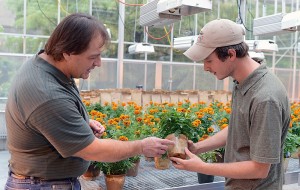
Kenny McCabe and James Schrader grabbed two pots of marigolds and placed them on a greenhouse bench.
On the left, in a pot made from a biorenewable mix of soy protein and polylactic acid, was a thick plant with three orange-gold blooms and four buds about to pop, its leaves a rich and dark green.
The marigold on the left is growing in a pot made from bioplastics. The plant on the right is growing in a pot made from a petroleum-based plastic.
On the right, in a pot made from petroleum-based plastic, was a short, thin and yellowing plant with three flowers and three buds.
McCabe, a research associate and graduate student in horticulture at Iowa State University, and Schrader, an assistant scientist in horticulture, explained that each plant was grown in the same soil, the same light and the same temperatures. Both were fertilized for two weeks, then no fertilizer for four weeks.
“This one is still green and it hasn’t been fed for four weeks,” McCabe said. “It’s pretty incredible. You have to feed the plant in the petroleum pot a lot more.”
That’s because the soy-based pot actually degrades over time, slowly releasing nitrogen, phosphorous, potassium and other nutrients valuable for plant growth, Schrader said. That has researchers breaking up some of the pots, dropping the pieces into the holes dug for plants and testing the pots’ effectiveness as a fertilizer.
The two researchers are part of a five-year study of the production and performance of different kinds of bioplastic pots. The study is supported by a $1.94 million grant from the U.S. Department of Agriculture and led by William Graves, a professor of horticulture and associate dean of Iowa State’s Graduate College. And it’s a good example of the work Iowa State’s Biopolymers and Biocomposites Research Team is doing.
David Grewell, an associate professor of agricultural and biosystems engineering and chairman of the research team, said the team has been around since 1995 and has grown to 21 members from 12 departments and four colleges. It operates within the Center for Crops Utilization Research. Its researchers have won $6.5 million in research grants over the past five years.
One of those is a $16,000 planning grant from the National Science Foundation to build support for a proposed Center for Bioplastics and Biocomposites (CB²) based at Iowa State.
If established and approved by the Iowa Board of Regents, the proposed center would be part of the science agency’s Industry/University Cooperative Research Center Program. It would be a collaborative effort of researchers from Iowa State, the University of Massachusetts Lowell and the agriculture and plastics industries.
Grewell said the proposed center has three major goals: to improve the basic understanding of the processing and properties of bioplastics; to provide reliable data about bioplastics for industry; and to support large-scale manufacture and use of biorenewable plastics.
“Researchers here at Iowa State encompass the whole gamut of bioplastics,” Grewell said. “We have people who study the feedstocks, the chemistry, the synthesis, the performance and the economics. We’re well positioned to lead this center. It makes sense for it to happen here in the breadbasket of the country. The feedstocks and the expertise are all here.”
Iowa State’s biopolymers research team has also been awarded $250,000 over two years from a $7.5 million state appropriation supporting Iowa State’s Leading the Bioeconomy Initiative.
Grewell said the state money will help the research team:
- make company visits to promote partnerships with the proposed industry center
- meet with federal decision makers in support of biorenewable grants and policies
- hire additional staff, particularly a grant writer
- and increase industry engagement by improving the team’s presence at trade shows.
All of that, Grewell said, will help the research team work toward its long-term goals of helping bioplastics capture at least 20 percent of the plastics market and transferring bioplastic technologies from the university to Iowa startup companies.
Back in Iowa State’s horticulture labs and greenhouses, Schrader explained the bottom line of all the studies, plans and proposals by Iowa State’s Biopolymers and Biocomposites Research Team:
“The idea,” he said, “is to come up with biorenewable alternatives that work as well or better than petroleum plastics.”
Story first appeared here.